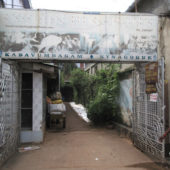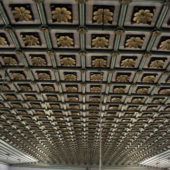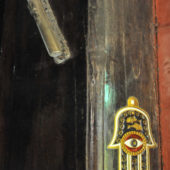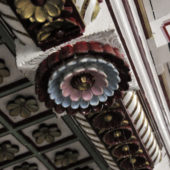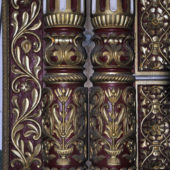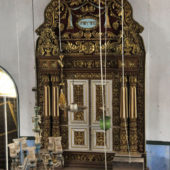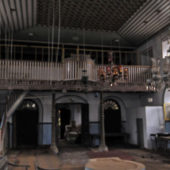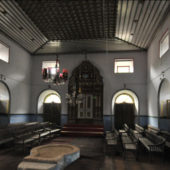Kadavumbagam’s foundation was laid in the 1200s; the building rebuilt in the 1700s and due to dwindling Jewish population the synagogue was closed in the late 20th century. The entire Torah ark and bemah were then transported to Moshav Nehalim, Israel where the synagogue interior was reconstructed.
Native Jews of Ernakulum claim that the original Kadavumbagam Synagogue was built in the medieval port of Cranganore. One story relates that the Moors had arrived sometime earlier and had developed a good relationship with the native ruler. The Jews became involved in the lucrative spice trade and the Moors looked at them as competition to be gotten rid of. Therefore, the Moors persecuted the Jews and eventually they left their synagogue at Cranganore and re-settled in Ernakulum in 1154. The Rajah of Cochin was sympathetic to their plight and protected them. In 1200 they built the Kadavumbagam Synagogue. Another story indicates that in 1524, the Jews in Cranganore fled persecution by the Moors and settled in Ernakulum. A third tale indicates that in the mid 16th century, Jews in the area surrounding Ernakulum fled persecution by the Portuguese, thus winding up in Ernakulum under the beneficent hand of the Rajah of Cochin.
The current guardian of the Synagogue, Elias Josephai, relates that after that time, the building as it is today is much as it was in the early 16th to early 17th centuries. The two-storied front section was made higher and wider approximately one century later. Both sections replaced earlier structures of unknown dates, which are believed to have stood on the same site. The Synagogue is located on Market Square, set back from the clamor expected, when being located on the main thoroughfare through the market area of the town. Unusual for synagogues in the Kerala region, there is no gatehouse. Usually there would be a gatehouse in connection with the synagogue, facing the road. Perhaps that is what one of the original structures represents – it is unknown whether there ever was one. After Israel became a nation in 1948, many of the congregation emigrated to Israel, causing the membership in Ernakulum to dwindle. Kadavumbagam Synagogue continued to function until 1972, when its membership could no longer support it. By 1974 the Torah scrolls were shipped to the Cochin National Heritage Center in Israel. In 1975 a serious storm struck Ernakulum, damaging the Synagogue. In 1977 thieves broke into the Synagogue and stole some artifacts. In 1979 the Synagogue gave its ownership over to one of its longstanding congregants, Elias Josephai. In 1991 the interior of the Synagogue, including the Aron Kodesh, was purchased and shipped to Moshav Nehalim in Jerusalem for restoration and reconstruction. The Synagogue lay vacant for the next 5 years, until Josephai established a business in the front building. He is slowly renovating the rear building, the syngogue. He allows visitors to tour the Synagogue and grounds.
The building is constructed of locally quarried laterite stone blocks, coated in whitewashed chuman (polished lime plaster) and brick. Attractive arched windows and wood shutters grace the Synagogue, as well as a welcoming entranceway framed by a brick arch. The portion of the Synagogue that houses the entrance is half-octagonal in shape, which is unusual in a Kerala synagogue. The ground floor was used as a social hall and overflow room for High Holidays and special occasions. There were rooms on the second floor that were used as a Jewish school. Behind the prayer room is the azara, the anteroom common in Kerala synagogues. This was named after the Temple in Jerusalem, where animal sacrifices took place. In synagogues, the azara is used as an arrival space (lobby) and to observe the ritual washing of hands. At the Kadavumbagam Synagogue, the windowed azaza leads to the large prayer room, with ten arched windows, symbolizing The Ten Commandments. Of note are the intricate detail of the hand-carved and double-pilastered, hand-painted and gilded heckal and the spectacularly decorated and painted ceiling of the Indian lotus flower in a grid pattern. As is customary in Kerala synagogues, the women’s gallery is upstairs with a beautiful balustrade, curved outward in the center, in which is placed a second tivah (reader’s desk). This was also where the Jewish school took place. The first tivah was in the center of the prayer room. The Synagogue was arranged facing northward, towards Jerusalem. Wood benches were arranged around the lower bema and against the walls. The wood floor was covered with carpets or mats on which the congregants would walk barefoot.

